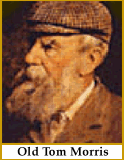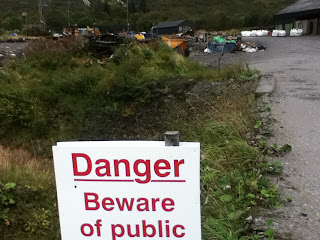The project itself, I feel, has gone pretty well. The classes were taught here, the online classes were completed with my students back home, and contacts, relationships, and ideas have been generated to develop future involvement of WITC students with the Wisconsin In Scotland program. I have created documents containing recommendations and reports - important, but too boring for this venue - and sent them back to the International Education Committee for its use. In summary, this work, along with the blog, has been my assignment.
I hesitate to try to create a summary of Scotland itself, as it is a place much too diverse, complex, and long-historied to lend itself to summary. Suffice it to say that I have been taken in by its charm, land, and great people. The story of Scotland is by no means static. Currently, there is much to be hopeful for in its future.
As the Scottish Parliament discusses possible independence from the United Kingdom, development of renewable energy, and renewable energy technologies for export (recently, a Scottish based company sold the first "wave machine" to Spain to generate electricity from tidal and wave action), as well as innovative proposals for education and employment of its youth - the continual transformation, that is constant in the story of Scotland, forges ahead. This country seems a natural partner for Wisconsin in its landscape, weather, people, and vision, as we look more globally for opportunity and sustainable growth.
The ability of communities to change over time is apparent here. It is encouraging to see that this has happened over the hundreds of years of history, as we currently are going through some change worldwide. From great Scottish writers and philosophers, such as Henry Home,* and Francis Hutchenson* we see that Scotland, like most European countries has moved through time from nomadic hunters, to agriculturists, to merchants, to industrialists - and the government, social mores, and laws has had to change with it. If a system does not work to the benefit of the majority - it will change.
*Henry Home -
was a lawyer from Berwickshire who joined the Faculty of Advocates in 1723. When appointed a judge in 1752 he took the title Lord Kames. He was a leading agricultural improver of his day, most notably at Blair Drummond on the estates of his wife, where he partially reclaimed large areas of the huge Flanders Moss.
He had a finger in many pies, helping to manage those estates forfeited by Jacobite landowners after the ’45 Rebellion; and he was also on the Board of Trustees for Encouraging the Fisheries, Arts and Manufactures of Scotland.
As Lord Kames, he became a central figure in the Scottish Enlightenment, a founder member of the Edinburgh Philosophical Society and a luminary of the Select Society; and as a man of ideas he was author of many books, covering everything from philosophy, history, literature and law to weighty tomes on agricultural improvement: ‘The Gentleman Farmer’ (1776) was over 400 pages long. His protégés included David Hume, James Boswell and Adam Smith.
As Lord Kames, he became a central figure in the Scottish Enlightenment, a founder member of the Edinburgh Philosophical Society and a luminary of the Select Society; and as a man of ideas he was author of many books, covering everything from philosophy, history, literature and law to weighty tomes on agricultural improvement: ‘The Gentleman Farmer’ (1776) was over 400 pages long. His protégés included David Hume, James Boswell and Adam Smith.
*Francis Hutcheson
- reacted against both the psychological egoism of Thomas Hobbes and the rationalism of Samuel Clarke and William Wollaston. As regards Hobbes, Hutcheson thought his doctrine was both wrong and dangerous; wrong because by the frame of our nature we have compassionate, generous and benevolent affections which owe nothing at all to calculations of self-interest, and dangerous because people may be discouraged from the morally worthy exercise of cultivating generous affections in themselves on the grounds that the exercise of such affections is really an exercise in dissimulation or pretence. As against Hobbes Hutcheson held that a morally good act is one motivated by benevolence, a desire for the happiness of others. Indeed the wider the scope of the act the better, morally speaking, the act is; Hutcheson was the first to speak of “the greatest happiness for the greatest numbers”.
He believed that moral knowledge is gained via our moral sense. A sense, as the term is deployed by Hutcheson, is every determination of our minds to receive ideas independently of our will, and to have perceptions of pleasure and pain. In accordance with this definition, the five external senses determine us to receive ideas which please or pain us, and the will does not intervene — we open our eyes and by natural necessity see whatever it is that we see. But Hutcheson thought that there were far more senses than the five external ones. Three in particular play a role in our moral life. The public sense is that by which we are pleased with the happiness of others, and are uneasy at their misery. The moral sense is that by which we perceive virtue or vice in ourselves or others, and derive pleasure, or pain, from the perception.
For more on the Scottish Enlightenment period go to:
http://www.martinfrost.ws/htmlfiles/scottish_enlighten.html
It would be great for students to get a wider view of the world and a deeper understanding of our own country's history by coming here to study. Scotland is moving forward as it has done from Highlander, to Tobacco Lords, to ship builders, to energy technology. We have got to get ahead of the curve on something to get ahead. An experience like this one at Dalkeith house can help our students get ahead. Forward!
Sorry for not summarizing for so long...Now, getting back to our leaving Dalkeith House, we are all busy cleaning the palace in order to leave it in as good, or in better shape than we found it.
The students and staff are all either packing for home or packing for the next leg of their trip. Talk of the future predominates the conversation along with bits of honesty about how much we are all going to miss living and studying in Scotland, but also about how nice it will be to get home. I think that, over time, we will all look back on this experience as a pretty special one.
The students will have a little time off to enjoy their holidays, as the term started on the 10th of August and is ending this week. We had a really good group of students this term. Somehow they managed to take part in all the cultural activities offered, spent time in the city going to clubs, pubs, parks, museums, and more. They also traveled to other countries on breaks, and turned in some high quality academic work to boot! They are tired but happy. Ah - Youth!
_________________________________________________________________________________
As a part of our concluding events, after cleaning all day, we spiffed ourselves up and had a nice final dinner. It was a "Burns Night" dinner. This tradition usually happens in January, but we figured, "what the heck."
Our chef, Henry, organized it along with help of the Assistant Director, Katie. The Burns Night Dinner is a grand tradition where there is much pomp and regalia surrounding the famous Scottish dish of haggis. The event includes specific music, speeches, readings, and toasts done in a traditional order. For the details of a Burns Night Dinner go to:
http://www.bbc.co.uk/robertburns/burnsnight/running_order.shtml
I was honored to read the "Ode to Haggis." I did my best to deliver the poem in Scots dialect, but due to nerves, it came out a bit halting. The poem, read to the giant lump of sausage, made from "parts" of a sheep, goes as follows:
Fair fa' your honest, sonsie face,
Great chieftain o' the pudding-race!
Aboon them a' ye tak your place,
Painch, tripe, or thairm :
Weel are ye wordy o'a grace
As lang's my arm.
The groaning trencher there ye fill,
Your hurdies like a distant hill,
Your pin wad help to mend a mill
In time o'need,
While thro' your pores the dews distil
Like amber bead.
His knife see rustic Labour dight,
An' cut you up wi' ready sleight,
Trenching your gushing entrails bright,
Like ony ditch;
And then, O what a glorious sight,
Warm-reekin', rich!
Then, horn for horn, they stretch an' strive:
Deil tak the hindmost! on they drive,
Till a' their weel-swall'd kytes belyve
Are bent like drums;
Then auld Guidman, maist like to rive,
Bethankit! hums.
 |
| The head table prepares for the official toast by the guest of honor. |
 |
| Cameron, guest of honor; Henry, haggis chef; me, ode reader |
The evening served as a nice capstone to a great semester full of learning, friendship, and exploration of place and self.
 |
| A couple of the tables of folks at the dinner. |
As for Denise and myself, we will be packing our bags for some travel to other European destinations. Specifically, we will go to Ireland for a week (my trip), Italy for a week, (Denise's trip) - then get to London and Paris for a couple of days each as well. In between we will spend a night here and there in Glasgow and Edinburgh as well. We still have not come close to exhausting these interesting and vibrant cities, but we have absolutely enjoyed trying!
And so, we will go back from whence we came, with memories and wisdom gained from time abroad in this land called Scotland, to our home in the North woods of Wisconsin.
...Oh, that's right. The season will have changed. Home will look more like this:



































































